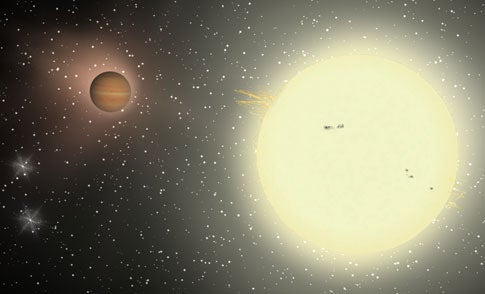An international team of astronomers with the Trans-atlantic Exoplanet Survey have discovered TrES-4, an extrasolar planet in the constellation of Hercules. The new planet was identified by astronomers looking for transiting planets — planets that pass in front of their home stars — using a network of small automated telescopes in Arizona, California, and the Canary Islands. TrES-4 was discovered less than half a degree (about the size of the Full Moon) from the team’s third planet, TrES-3.
“TrES-4 is the largest-known exoplanet,” said Georgi Mandushev, an astronomer at Lowell Observatory. “It is about 70 percent bigger than Jupiter, the solar system’s largest planet, but less massive, making it a planet of extremely low density. Its mean density is only about 0.2 grams per cubic centimeter, or about the density of balsa wood. And because of the planet’s relatively weak pull on its upper atmosphere, some of the atmosphere probably escapes in a comet-like tail.”
The planet was first noticed by Lowell Observatory’s Planet Search Survey Telescope (PSST), set up and operated by Mandushev and Edward Dunham, a Lowell Observatory instrument scientist. The Sleuth telescope, maintained at Caltech’s Palomar Observatory, also observed transits of TrES-4, confirming the initial detections. TrES-4 is about 1,400 light years away and orbits its host star in three and a half days. Being only about 4.5 million miles from its home star, the planet is also very hot, about 1,600 Kelvin or 2,300° Fahrenheit.
“TrES-4 appears to be something of a theoretical problem,” said Dunham. “It is larger relative to its mass than current models of superheated giant planets can presently explain. Problems are good, though, since we learn new things by solving them.”
“We continue to be surprised by how relatively large these giant planets can be,” adds Francis O’Donovan, a graduate student in astronomy at the California Institute of Technology who operates one of the TrES telescopes. ” But if we can explain the sizes of these bloated planets in their harsh environments, it may help us understand better our own solar system planets and their formation.”
A transiting planet passes directly between Earth and the star, blocking some of the star’s light and causing a slight drop in its brightness. To look for transits, the small telescopes are automated to take wide-field timed exposures of the clear skies on as many nights as possible. When observations are completed for a particular field, usually over a two-month period, astronomers measure very precisely the light from every star in the field in order to detect the possible signature of a transiting planet.
“TrES-4 blocks off about one percent of the light of the star as it passes in front of it,” said Mandushev. “With our telescopes and observing techniques, we can measure this tiny drop in the star’s brightness and deduce the presence of a planet there.”
Not only is the planet TrES-4 mysterious and intriguing, but so is its host star, cataloged as GSC 02620-00648. Mandushev explains: “The host star of TrES-4 appears to be about the same age as our Sun, but because it is more massive, it has evolved much faster. It has become what astronomers call a ‘subgiant,’ or a star that has exhausted all of its hydrogen fuel in the core and is on its way of becoming a ‘red giant,’ a huge, cool red star like Arcturus or Aldebaran.”
In order to help confirm they had found a planet, Gáspár Bakos of the Hungarian Automated Telescope Network (HATNet) and Harvard’s Guillermo Torres switched from the 10-centimeter TrES telescopes to one of the 10-meter telescopes at the W. M. Keck Observatory on the summit of Mauna Kea in Hawaii. Using this giant telescope, they confirmed that the TrES team had indeed found a new planet. In order to measure accurately the size and other properties of TrES-4, astronomers also made follow up observations with bigger telescopes at Lowell Observatory and Fred L. Whipple Observatory in Arizona.










